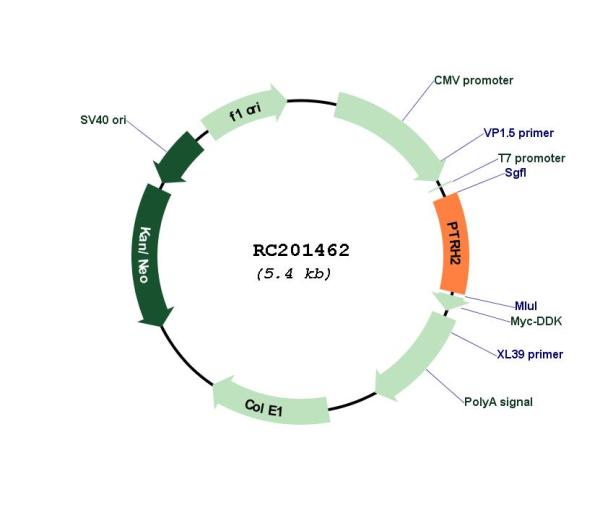PTRH2 (NM_016077) Human Tagged ORF Clone
CAT#: RC201462
PTRH2 (Myc-DDK-tagged)-Human peptidyl-tRNA hydrolase 2 (PTRH2), nuclear gene encoding mitochondrial protein
ORF Plasmid: tGFP
Lentiviral Particles: DDK DDK w/ Puro mGFP mGFP w/ Puro
AAV Particle: DDK
"NM_016077" in other vectors (6)
USD 198.00
Specifications
| Product Data | |
| Type | Human Tagged ORF Clone |
| Tag | Myc-DDK |
| Symbol | PTRH2 |
| Synonyms | BIT1; CFAP37; CGI-147; IMNEPD; PTH; PTH 2; PTH2 |
| Vector | pCMV6-Entry |
| E. coli Selection | Kanamycin (25 ug/mL) |
| Mammalian Cell Selection | Neomycin |
| Sequence Data |
>RC201462 ORF sequence
Red=Cloning site Blue=ORF Green=Tags(s) TTTTGTAATACGACTCACTATAGGGCGGCCGGGAATTCGTCGACTGGATCCGGTACCGAGGAGATCTGCC GCCGCGATCGCC ATGCCCTCCAAATCCTTGGTTATGGAATATTTGGCTCATCCCAGTACACTCGGCTTGGCTGTTGGAGTTG CTTGTGGCATGTGCCTGGGCTGGAGCCTTCGAGTATGCTTTGGGATGCTCCCCAAAAGCAAGACGAGCAA GACACACACAGATACTGAAAGTGAAGCAAGCATCTTGGGAGACAGCGGGGAGTACAAGATGATTCTTGTG GTTCGAAATGACTTAAAGATGGGAAAAGGGAAAGTGGCTGCCCAGTGCTCTCATGCTGCTGTTTCAGCCT ACAAGCAGATTCAAAGAAGAAATCCTGAAATGCTCAAACAATGGGAATACTGTGGCCAGCCCAAGGTGGT GGTCAAAGCTCCTGATGAAGAAACCCTGATTGCATTATTGGCCCATGCAAAAATGCTGGGACTGACTGTA AGTTTAATTCAAGATGCTGGACGTACTCAGATTGCACCAGGCTCTCAAACTGTCCTAGGGATTGGGCCAG GACCAGCAGACCTAATTGACAAAGTCACTGGTCACCTAAAACTTTAC ACGCGTACGCGGCCGCTCGAGCAGAAACTCATCTCAGAAGAGGATCTGGCAGCAAATGATATCCTGGATT ACAAGGATGACGACGATAAGGTTTAA >RC201462 protein sequence
Red=Cloning site Green=Tags(s) MPSKSLVMEYLAHPSTLGLAVGVACGMCLGWSLRVCFGMLPKSKTSKTHTDTESEASILGDSGEYKMILV VRNDLKMGKGKVAAQCSHAAVSAYKQIQRRNPEMLKQWEYCGQPKVVVKAPDEETLIALLAHAKMLGLTV SLIQDAGRTQIAPGSQTVLGIGPGPADLIDKVTGHLKLY TRTRPLEQKLISEEDLAANDILDYKDDDDKV |
| Chromatograms |
CHROMATOGRAMS
 Sequencher program is needed, download here. |
| Restriction Sites |
SgfI-MluI
Cloning Scheme for this gene
Plasmid Map

|
| ACCN | NM_016077 |
| ORF Size | 537 bp |
| OTI Disclaimer | The molecular sequence of this clone aligns with the gene accession number as a point of reference only. However, individual transcript sequences of the same gene can differ through naturally occurring variations (e.g. polymorphisms), each with its own valid existence. This clone is substantially in agreement with the reference, but a complete review of all prevailing variants is recommended prior to use. More info |
| OTI Annotation | This clone was engineered to express the complete ORF with an expression tag. Expression varies depending on the nature of the gene. |
| Product Components | The ORF clone is ion-exchange column purified and shipped in a 2D barcoded Matrix tube containing 10ug of transfection-ready, dried plasmid DNA (reconstitute with 100 ul of water). |
| Reconstitution | 1. Centrifuge at 5,000xg for 5min. 2. Carefully open the tube and add 100ul of sterile water to dissolve the DNA. 3. Close the tube and incubate for 10 minutes at room temperature. 4. Briefly vortex the tube and then do a quick spin (less than 5000xg) to concentrate the liquid at the bottom. 5. Store the suspended plasmid at -20°C. The DNA is stable for at least one year from date of shipping when stored at -20°C. |
| Reference Data | |
| RefSeq | NM_016077.5 |
| RefSeq Size | 804 bp |
| RefSeq ORF | 540 bp |
| Locus ID | 51651 |
| UniProt ID | Q9Y3E5 |
| Cytogenetics | 17q23.1 |
| Protein Families | Transmembrane |
| MW | 19.2 kDa |
| Gene Summary | The protein encoded by this gene is a mitochondrial protein with two putative domains, an N-terminal mitochondrial localization sequence, and a UPF0099 domain. In vitro assays suggest that this protein possesses peptidyl-tRNA hydrolase activity, to release the peptidyl moiety from tRNA, thereby preventing the accumulation of dissociated peptidyl-tRNA that could reduce the efficiency of translation. This protein also plays a role regulating cell survival and death. It promotes survival as part of an integrin-signaling pathway for cells attached to the extracellular matrix (ECM), but also promotes apoptosis in cells that have lost their attachment to the ECM, a process called anoikos. After loss of cell attachment to the ECM, this protein is phosphorylated, is released from the mitochondria into the cytosol, and promotes caspase-independent apoptosis through interactions with transcriptional regulators. This gene has been implicated in the development and progression of tumors, and mutations in this gene have been associated with an infantile multisystem neurologic, endocrine, and pancreatic disease (INMEPD) characterized by intellectual disability, postnatal microcephaly, progressive cerebellar atrophy, hearing impairment, polyneuropathy, failure to thrive, and organ fibrosis with exocrine pancreas insufficiency (PMID: 25574476). Alternative splicing results in multiple transcript variants encoding different isoforms. [provided by RefSeq, Mar 2015] |
Documents
| Product Manuals |
| FAQs |
| SDS |
Resources
Other Versions
| SKU | Description | Size | Price |
|---|---|---|---|
| RC201462L1 | Lenti ORF clone of Human peptidyl-tRNA hydrolase 2 (PTRH2), nuclear gene encoding mitochondrial protein, Myc-DDK-tagged |
USD 600.00 |
|
| RC201462L2 | Lenti ORF clone of Human peptidyl-tRNA hydrolase 2 (PTRH2), nuclear gene encoding mitochondrial protein, mGFP tagged |
USD 600.00 |
|
| RC201462L3 | Lenti ORF clone of Human peptidyl-tRNA hydrolase 2 (PTRH2), nuclear gene encoding mitochondrial protein, Myc-DDK-tagged |
USD 600.00 |
|
| RC201462L4 | Lenti ORF clone of Human peptidyl-tRNA hydrolase 2 (PTRH2), nuclear gene encoding mitochondrial protein, mGFP tagged |
USD 600.00 |
|
| RG201462 | PTRH2 (tGFP-tagged) - Human peptidyl-tRNA hydrolase 2 (PTRH2), nuclear gene encoding mitochondrial protein |
USD 500.00 |
|
| SC323788 | PTRH2 (untagged)-Human peptidyl-tRNA hydrolase 2 (PTRH2), nuclear gene encoding mitochondrial protein |
USD 300.00 |
{0} Product Review(s)
Be the first one to submit a review






























































































































































































































































 Germany
Germany
 Japan
Japan
 United Kingdom
United Kingdom
 China
China




